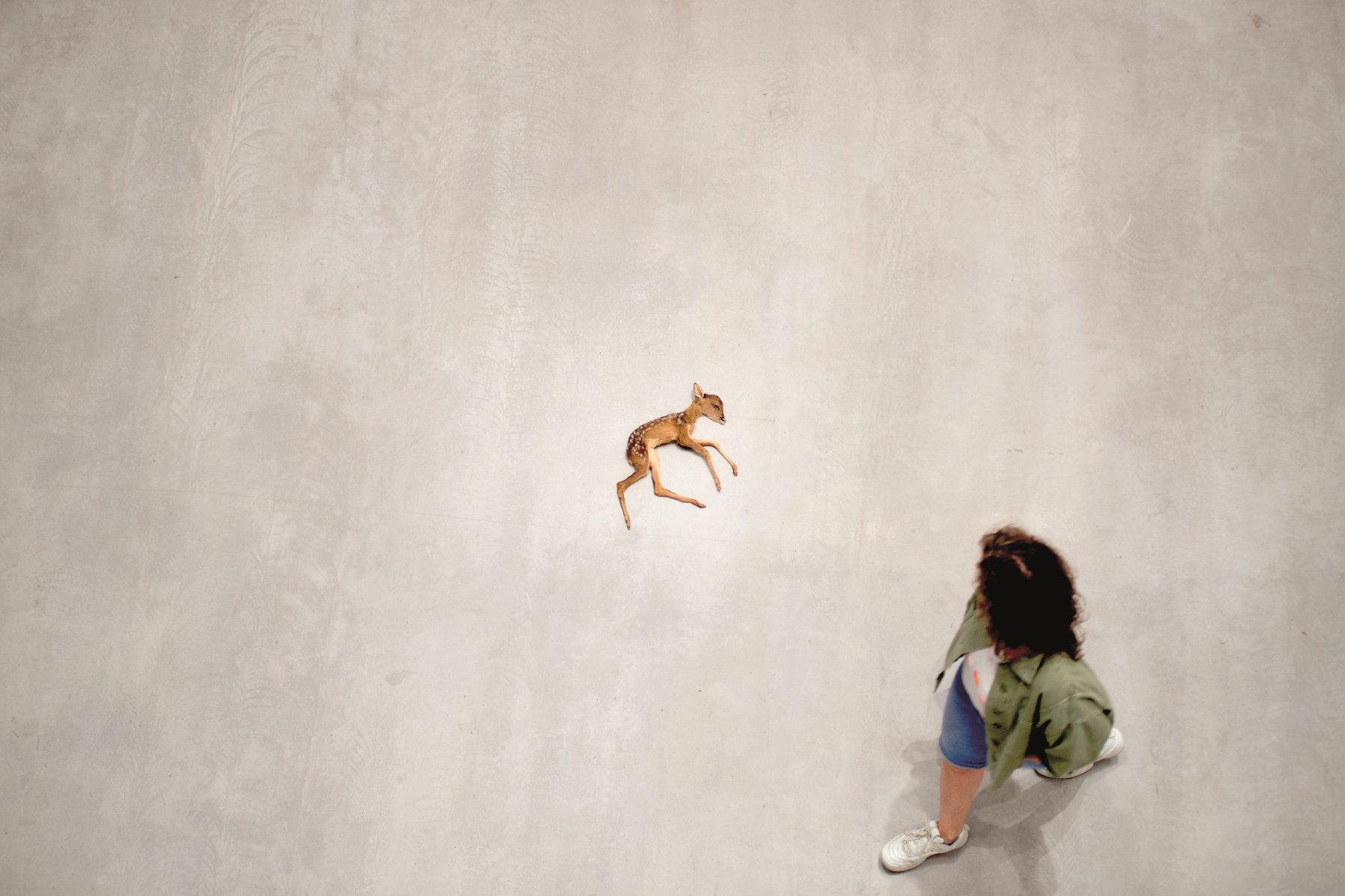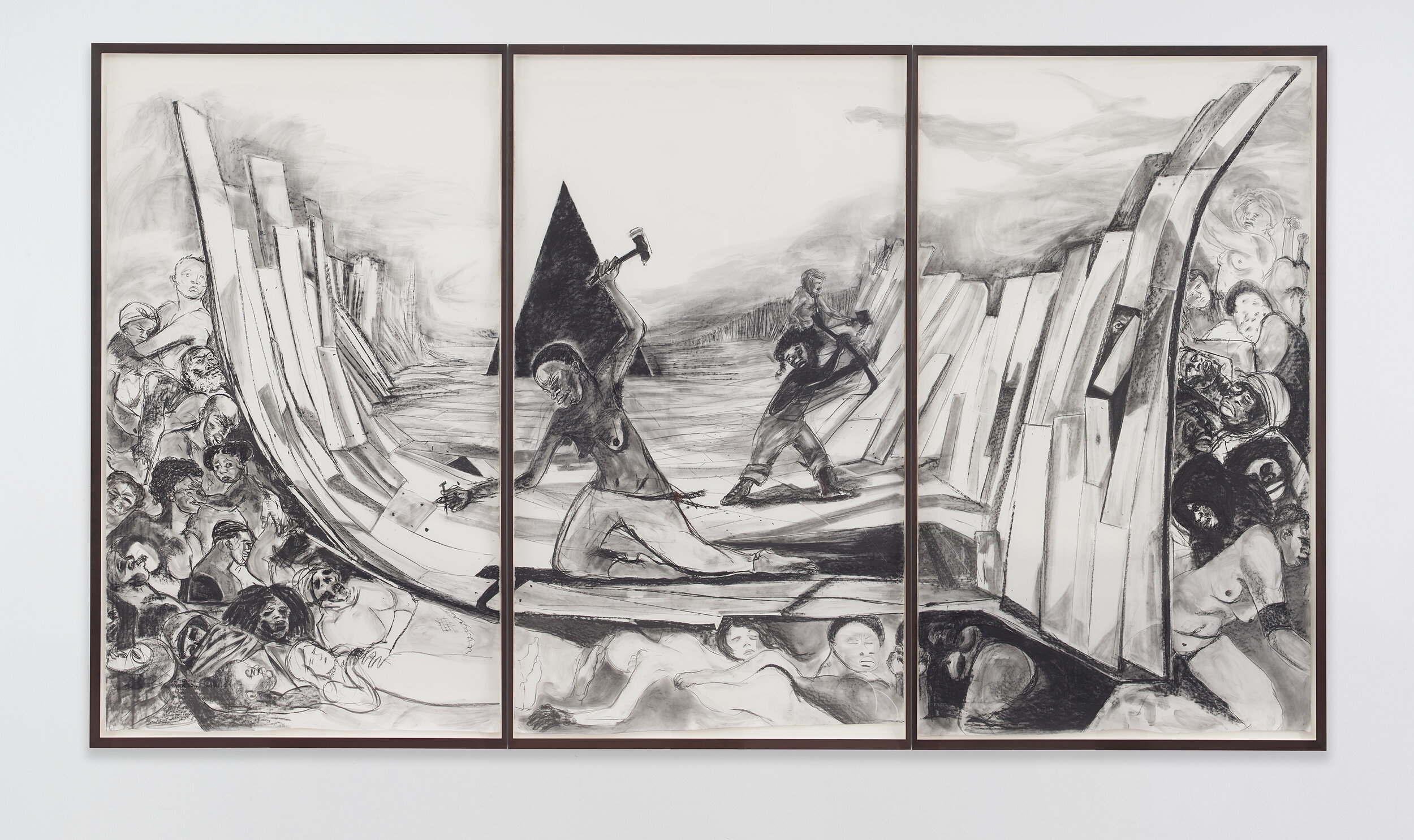text by Tara Anne Dalbow
Upon entering Hugh Hayden’s Hughman exhibition at Lisson Los Angeles, you’re confronted by three interconnected rows of metallic stall doors, the same as you might find in a public restroom. The doors simultaneously invite you toward entry and expel you, intriguing as they are impersonal and ominous. Before you glimpse an object resembling art, you’re implicated in the hidden meaning, an active participant in its revelation. You’re immediately made aware of the physicality of your body, your relationship to the space, and the identity you present to the unknown system of order. Questions arise: Is this a gendered bathroom? Do I belong here? Who am I sharing the space with? The interactive element of opening and closing each door, maneuvering in, out, and between the confined, private spaces, renders engaging from a disembodied perspective nearly impossible. As the exhibition's title implies, there’s no leaving one’s hughmanity at the door.
My initial impression of imposition and interest follows me into the first stall, where a carved commode sprouts a bramble of thorny fir tree branches. The protrusion of sharp limbs obstructs further inspection; the effect is claustrophobic and disconcerting, and I back out cautiously. Behind the next door, a baby’s crib constructed from barbed wire and chain link fencing; behind another, interlocking wedding rings with Descovy pills [HIV antiviral] where the solitaire would be; and behind yet another, a classroom desk consumed entirely by abrasive white nylon bristles. Each object offers participation in a facet of contemporary American life under conditions as unwelcoming, uncomfortable, and caustic as the specular toilet seat.
The visceral materiality of the various textures, though not physically touched, commandeer the senses as the bristles scrape, the barbs prick, and the branches snag against your skin. Prongs, spurs, and skewers disrupt movement and threaten physical confrontation while also poking metaphorical holes in expectations and illusions. Here, the most fundamental promises of the American dream, like the right to an education, are rendered onerous, animating the question: for whom were these institutions made? If the skin you’re in determines your experience, and the object's surface or skin reflects the relative ease or distress of the encounter, then certainly not for the artist, a Black queer man, and by association, those like him.
Hugh Hayden
Cleanse, 2023
High density polyethylene bristles, cast resin
66 x 38.1 x 35.6 cm
26 x 15 x 14 in
© Hugh Hayden, Courtesy Lisson Gallery
Hugh Hayden
Start 'Em Young, 2023
Chain link fencing and hardware
142.9 x 141 x 81.3 cm
56 1/4 x 55 1/2 x 32 in
© Hugh Hayden, Courtesy Lisson Gallery
Hugh Hayden
Brainwash, 2023
PVC and nylon bristles
83.8 x 66 x 73.7 cm
33 x 26 x 29 in
© Hugh Hayden, Courtesy Lisson Gallery
As I continued around the room, the stalls began to feel more like dressing rooms with various identities available for perusal inside. Within one, a suit jacket and pants sewn from the rough and rigid bark of a cherry tree hang from a clothing rack. Elsewhere: a football helmet encompassed by boar hair, and still elsewhere: a bronze strap-on harness with a gun protruding from the crotch. The striking contrast between organic materials and those that are artificial and mass-produced recalls the antagonistic relationship between what’s natural and instinctual and what’s a consequence of sociopolitical structures. For whom are these spaces made?
Those capable of comfortably wearing the prosthetics of power appear as idealized, neoclassical male torsos carved from white silicone. They wear their means for control where their sex would be; for two, cocked pistols; for another, an abject skyscraper. A fourth iteration sees the male body replaced by a miniature basswood model church whose phallic steeple hangs limply across the shingled roof. In a nod to the dominant enterprise in Los Angeles, a director’s chair projects tapered wood penises in every direction. The appendages appear to both protect the seat of power and stage an assault on the unendowed who come too close. Their audacious vulgarity tempers the violence of the cultural implications and satirizes familiar tropes like toxic masculinity and the male impulse to think with an organ south of the brain.
When that door closes with a bang—emphasized by the acoustics of the room and made ominous by the presence of so many firearms—another door opens onto a bronze and acrylic sculpture of the waist and thighs of a man in navy uniform pants sporting a flashy leather belt, holstered gun, and handcuffs posed atop his white pedestal. Only when you move around the sculpture or are so moved by it do you see where the right side is sliced open to reveal beneath the uniform, armor, weaponry, beneath even the skin, the internal organs, veins, and bones within. The same veins in him that carry the red-blue blood between my heart and feet, the same stomach as the one that rumbles, hungry to be filled full when empty in Hayden, in him, in me. The man is twinned by another sculpture in the exhibition of a tree trunk spliced open to expose the biological contents of a womb carrying a luminous carved baby.
Hugh Hayden
Real Tree, 2023
Cherry bark on Zegna Suit
Suit: 99.1 x 91.4 x 17.8 cm
Suit: 39 x 36 x 7 in
© Hugh Hayden, Courtesy Lisson Gallery
Hugh Hayden
Eve, 2023
Cherry Bark and acrylic on resin, Black Walnut
63.5 x 38.1 x 25.4 cm
25 x 15 x 10 in
© Hugh Hayden, Courtesy Lisson Gallery
Their combined effect illuminates how stripped of societal status, we are of the same nature and origin and made from the same stuff. As intricately connected to one another as we are to the trees, the earth from which the trees grow, and the animals, like the stuffed buffalo in another stall, roam. Hanging together in a red-flocked closet, two raceless, genderless, crimson rib cages tenderly embrace—as the only forms made from material gentle enough to hold and be held. The fellow feeling carries me out of the closet, the stall, the gallery, and I re-enter the world a little more human than I was only an hour before.
Hughman is on view through January 13 @ Lisson Gallery, 1037 N. Sycamore Avenue, Los Angeles
Hugh Hayden
The Audition, 2023
Bald cypress, steel hardware and canvas
149.9 x 188 x 154.9 cm
59 x 74 x 61 in
© Hugh Hayden, Courtesy Lisson Gallery







